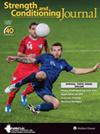Muscle Hypertrophy Response to Range of Motion in Strength Training: A Novel Approach to Understanding the Findings
IF 3
4区 医学
Q2 SPORT SCIENCES
引用次数: 1
Abstract
ABSTRACT One resistance training variable that may be altered to achieve desired outcomes is the range of motion used in training. Generally, the strength and conditioning field has accepted that using a greater range of motion in strength training exercises results in more substantial muscle hypertrophy outcomes. However, this theory has proved to be inconsistently supported in the literature, and to date, no sufficient explanation exists to explain this phenomenon. This review article seeks to outline a novel approach for potentially describing the disparities seen in range of motion research with respect to hypertrophy outcomes by applying the unique length-tension curve of each muscle being examined. As will be discussed in the review, virtually all the results from range of motion studies in various muscles have corresponded to each muscle's length-tension curve; muscles that are active on the descending limb of the curve appear to garner greater hypertrophy from using larger ranges of motion. Conversely, muscles that are not active on the descending limb exhibit similar adaptations despite alterations in range of motion. A novel hypothesis for applying this information to resistance training programs will be presented and discussed.力量训练中肌肉肥大对运动范围的反应:一种理解研究结果的新方法
摘要一个阻力训练变量是训练中使用的运动范围,它可以被改变以达到期望的结果。一般来说,力量和调节领域已经接受了在力量训练中使用更大的运动范围会导致更显著的肌肉肥大结果。然而,这一理论在文献中得到了不一致的支持,迄今为止,还没有足够的解释来解释这一现象。这篇综述文章试图通过应用所检查的每一块肌肉的独特长度-张力曲线,概述一种新的方法,以潜在地描述在运动范围研究中发现的与肥大结果有关的差异。正如将在综述中讨论的那样,几乎所有来自不同肌肉的运动范围研究的结果都对应于每个肌肉的长度-张力曲线;在曲线的下降肢体上活动的肌肉似乎因使用更大的运动范围而获得更大的肥大。相反,下行肢体上不活跃的肌肉表现出类似的适应能力,尽管运动范围发生了变化。将提出并讨论一个将这些信息应用于阻力训练项目的新假设。
本文章由计算机程序翻译,如有差异,请以英文原文为准。
求助全文
约1分钟内获得全文
求助全文
来源期刊

Strength and Conditioning Journal
社会科学-运动科学
CiteScore
4.70
自引率
8.00%
发文量
49
审稿时长
6-12 weeks
期刊介绍:
Strength and Conditioning Journal is the professional journal for strength coaches, personal trainers, physical therapists, athletic trainers, and other health professionals working in the strength and conditioning field. The journal’s mission is to publish articles that report both the practical applications of research findings and the knowledge gained by experienced professionals.
 求助内容:
求助内容: 应助结果提醒方式:
应助结果提醒方式:


